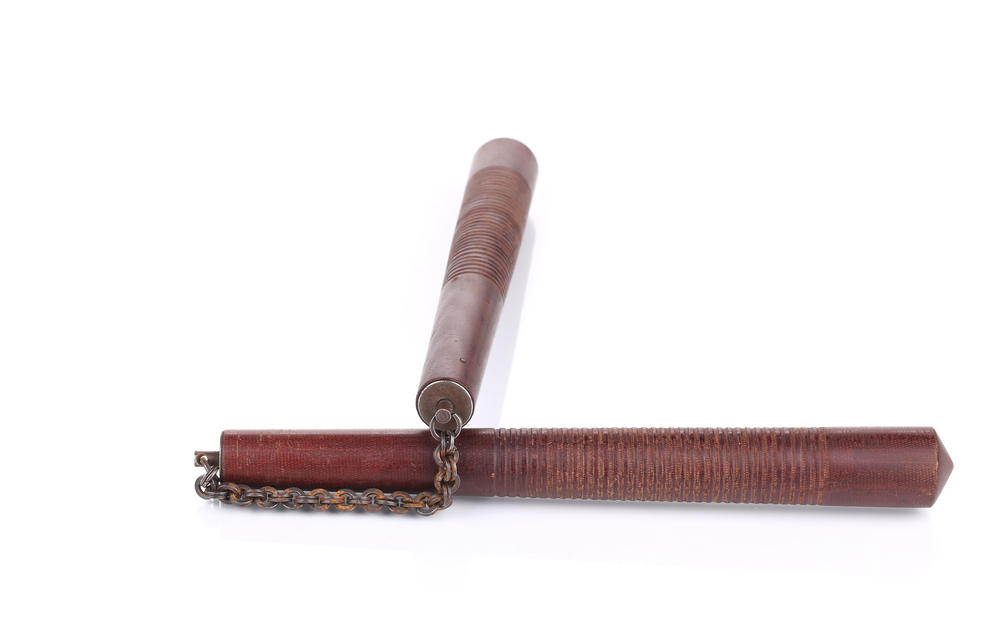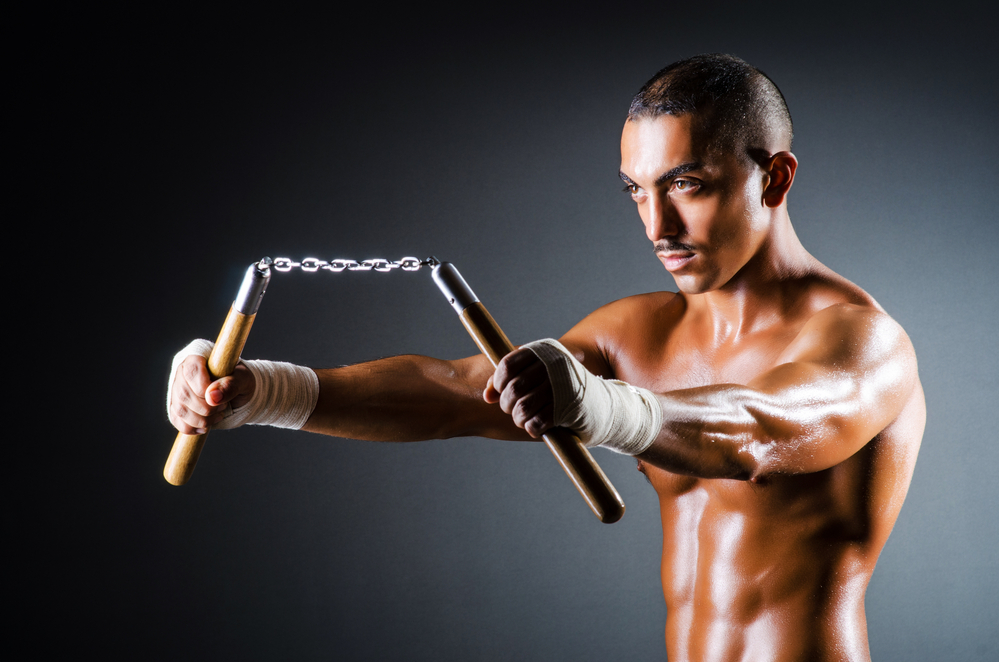The nunchaku weapon (widely referred to as “nunchucks”) being wielded with super speed, accuracy and power by Bruce Lee is one of the most iconic images of modern times.
The nunchaku weapon gained recognition largely in part to Bruce Lee using the weapon in the iconic ‘Enter the Dragon’ but also in ‘Game of Death’ and ‘Return of the Dragon’.
But what is the history of the nunchaku and how did such a specifically designed weapon come about?
What is the nunchaku?
The Nunchaku is a traditional Japanese martial art weapon originally from Okinawa.
The nunchaku weapon is made from of two hardwood sticks connected together by a short chain or rope.
There are many varieties of nunchakus but they are primarily made of two sections of wood connected by either a chain (kusari) or a cord (himo).
The person who practices this weapon is referred as “Nunchakuka”.

Nunchaku can be divided into traditional and modern. Traditional nunchaku are made from strong, flexible hardwood.
Modern nunchaku can be made from a range of other material including fibreglass, metal as well as hard wood.
Where did the Nunchaku Weapon Originate From?
The known history of the nunchaku weapon tells us that it originated from Okinawa which is part of the Ryuku Islads of Japan.
The Ryukyuan ethnic group of people are distinct from Japanese with their own language and culture. The Ryukyu’s or Nansei Islands are a chain of islands that stretch southwest from Kyushu to Taiwan.
This chain of Islands includes Okinawa where Karate is said to have originated form.
The word ‘nunchaku’ itself is from the Ryukyuan language.
Original Use in Farming
However it is believed that the birthplace of the nunchaku weapon is China where the original purpose of the nunchaku was in farming as a tool for harvesting wheat and rice.

One historical account of the origin of the nunchaku weapon involves Chinese Sung-Dynasty Emperor Jiu. The story tells of the Emperor being defeated in battle by the Mongolian army.
The Emperor retreated with his soldiers to regroup and came across villagers using a tool to help harvest wheat and rice which was made out of two sticks of different length tied together with a rope made out of rice hay and intertwined with horse hair.
It is told that Emperor Jiu developed fighting techniques using the farming tool and trained his army in usage of this new weapon for months before defeating the Mongolian Army.
Nunchaku Use in Different Martial Arts
The nunchaku is most widely used in martial arts such as Okinawan kobudō and karate.
However weapons similar to the nunchaku are also used in different martial arts around the world including:
- parts of China where it is called shuang chin kun or “a two- part flail”
- Philippine tabak-toyok the Filipino version tends to have shorter handles and a longer chain than its Okinawan counterpart, making it better suited for long range
- In Taekwondo and Hapkido from Korea Yi Jeol Bong 이절봉 (2 section sticks) or Ssang jeol gon 쌍절곤 (twin section staff)
- Shaolin sanjiegun which is the three-section-staff

Different Types of Nunchaku
Nunchaku is categorized in two types – traditional and modern.
Traditional nunchaku are usually made from strong flexible hardwood. They are used for training techniques used in combat and so the composition is designed to inflict damage.
Modern nunchaku are often made from metal, wood, fibreglass and other harder material. But in order to prevent injuries they are often covered with foam.
Modern nunchaku use is compeition setting has influenced design and composition.
Traditional Nunchaku
Traditional nunchaku are made from a strong, flexible hardwoodsuch as pasania, oak and loquat
The traditional types of nunchaku include:
Han-Kei
Half-size or split shaft. The two side fit together well for ease of concealment and taking up less space than larger sized nunchaku.
Maru-Gata
Rounded shaped nunchaku of standard length of about 2 feet 8 inches. Used mainly for training purposes.

Hakaku-Kei
Octagonal shape, these nunchaku are well suited for combat. The edges are designing to increase force on impact.
San-Setsu-Kon
Three section nunchaku that is similar to the three section staff from Shaolin but a smaller version of it. Usually around 5 ft in length.
Yon-Setsu-Kon
This nunchaku consists of four parts or sticks. Two of the sticks are of full length and two of half length.
So-Setsu-Kon
Long and short baton nunchaku. One short side prevents striking your own hand when chambering at the hip
Modern Nunchaku
Modern nunchaku are made from a variety of other material including hard wood like the more traditional nunchaku.

Modern nunchaku design and composition are also determined by compeition in the modern day. They are often covered with foam for safety purposes.
Freestyle Nunchaku
Freestyle Nunchaku compeition focuses more on impressive visaual displays of nunchaku rather than combat.
Freestyle nunchaku hold regular competitions with a standardized judging criteria and is open to all.
Among other factors freestyle nunchaku includes criteria such as:
- Constant of speed when performing the techniques
- Variation in techniques
- Control and movement
- Showmanship and entertainment
Nunchaku Combat Competitions
Combat with nunchaku in competition is one of the four elements of Sport Nunchaku.
Sport Nunchaku was developed in late 70’s and 80’s by Marc Brémart (Switzerland), and Raphael Schmitz (France).
Sport Nunchaku includes Combat, Kata, Freestlye nunchaku and Applicaiton.

In the Combat nunchaku area two competitors engage in combat with nunchaku while wearing protective gear including helmets and groin guards.
Are nunchaku illegal?
Possession of nunchaku weapon is illegal in many countries such as Norway, Spain, Germany, and Canada.
In the United States, the legal staus of nunchaku differs from state to state.
As examples, possessing nunchaku for personal use is not legal in New York, California, Arizona and Massachusetts but in other states keeping nunchaku is not seen to be as a criminal offence.
Australia follows the same individual state legal state system. Nunchaku is on a restricted weapon list in New South Wales which means a person cannot use the weapon without a permit.
In Germany, nunchaku have been illegal since April 2006, when they were declared a strangling weapon.
References
- https://en.wikipedia.org/wiki/Nunchaku#:~:text=The%20nunchaku%20is%20most%20widely,%2C%20wood%2C%20plastic%20or%20fiberglass.
- https://www.quora.com/Were-nunchucks-invented-for-martial-arts-films
- http://www.nunchaku-do.com/histor_e.htm
- http://nunchaku.forumbronibialej.pl/en/budowa.html
- https://expertfightingtips.com/en/tabak-toyok-the-filipino-nunchaku/
- http://www.1066.co.nz/Mosaic%20DVD/whoswho/text/Nunchaku%5b1%5d.htm



